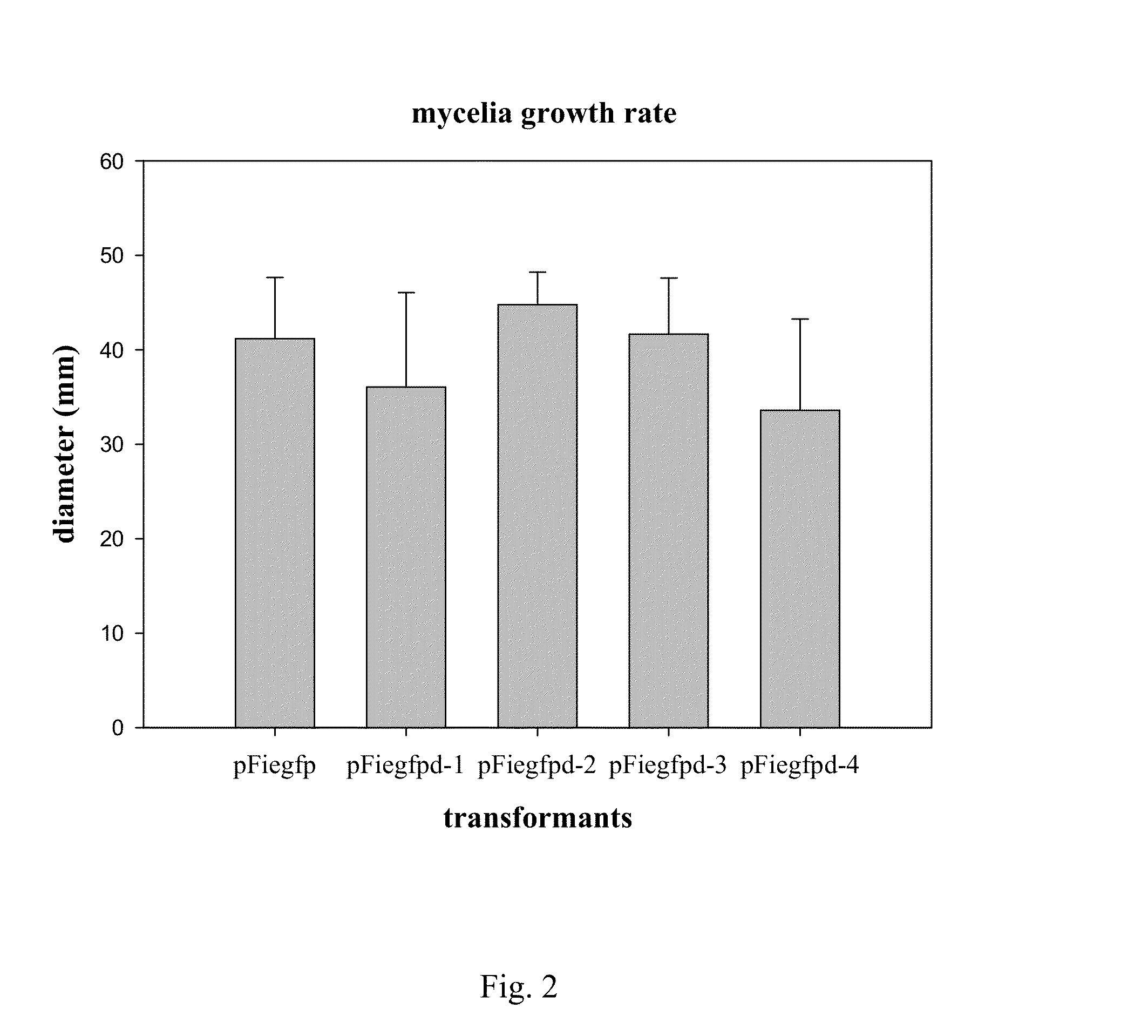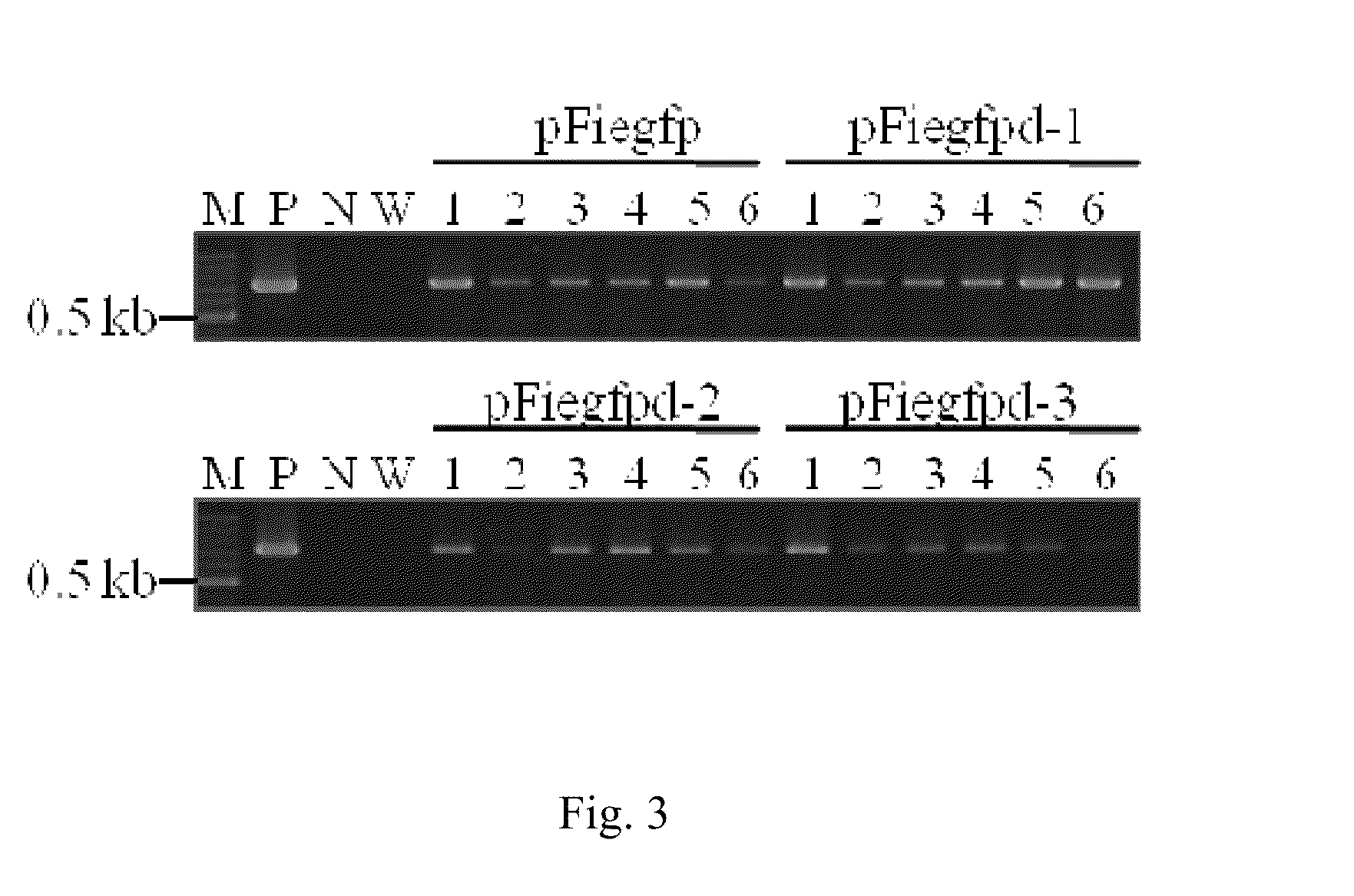Truncated glyceraldehyde-3-phosphate dehydrogenase promoter
a phosphate dehydrogenase and promoter technology, applied in the field of truncated glyceraldehyde-3-phosphate dehydrogenase promoter, can solve the problems that known expression vectors containing genetic regulatory elements for expression in filamentous fungi of the ascomycetes class cannot be efficiently expressed in filamentous fungi of the basidiomycetes class, and the genetic transformation is not sufficient to express heterologous genes
- Summary
- Abstract
- Description
- Claims
- Application Information
AI Technical Summary
Benefits of technology
Problems solved by technology
Method used
Image
Examples
example
Example 1
Construction of Plasmid Containing Truncated Promoters Strains and Media
[0047]F. velutipes BCRC 37086, purchased from the Bioresources Collection and Research Center (Hsinchu, Taiwan), was grown and maintained on CYM agar or broth (Difco, Detroit, Mich.) at 25° C. Escherichia coli DH5α, used for DNA manipulation and plasmid conservation, was grown in LB medium (Sigma, St Louis, Mo.) at 37° C. Agrobacterium tumefaciens strain LBA4404, kindly provided by Dr. Yee-Yung Charng, Agricultural Biotechnology Research Center, Academia Sinica (Taipei, Taiwan), was used for transformation and grown in LB medium at 28° C.
Fruiting of F. velutipes
[0048]A substrate composed of 65% sawdust and 35% rice bran was placed into a polypropylene bottle and autoclaved for 1 h. Capped bottles with substrates were inoculated with mycelial plugs and incubated at 23° C. for 3 to 4 weeks. After bottles were completely colonized by the mycelia, mushroom fruiting was induced by water addition and tempera...
example 2
Agrobactrium-Mediated Transformation Transformation of F. velutipes
[0050]Agrobacterium-mediated transformation was performed as described by Chen et al. (Chen et al., 2000) with minor modification. All expression vectors were introduced into A. tumefaciens by electroporation. The A. tumefaciens harbouring target plasmid was cultivated overnight in LB containing 50 μg / ml kanamycin with shaking at 220 rpm, followed by mixing with F. velutipes modified mycelia pellet (MMP) in induction medium (IM) which containing 200 μM acetosyringone (AS) for 6 h. The MMPs were subsequently transferred to fresh medium for 5 days. The MMP was then thoroughly washed and transferred to CYM plate containing 30 μg / ml hygromycin B and 200 μM cefotoxime, and incubated at 23° C. till the mycelia grew. The F. velutipes containing pFiegfp, pFiegfpΔd1, pFiegfpΔd2, pFiegfpΔd3 and pFiegfpΔd4 are named as D0, D1, D2, D3 and D4 transformants.
[0051]Plasmids with different length of gpd promoters, pFiegfp, pFiegfpΔd...
example 3
Detection of EGFP in Transformants
[0055]The expression of egfp was confirmed by western hybridization as shown in FIG. 5. Immunoblotting with the monoclonal anti-GFP antibody detected 27-kDa bands in positive control (PC) and total cellular protein of D1, D2 and D3 transformants, while D4 transformant showed no signal (data not shown).
[0056]The mycelia of putative transformants were examined by a fluorescent microscope (Eclipse E600, Nikon, Tokyo, Japan) using a Nikon B-2A filter (excitation filter, 450-490 nm; dichroic filter, 505 nm; barrier filter, 520 nm). An in vivo imaging system (IVIS) Spectrum (Caliper Life Sciences, Hopkinton, Mass.) was used to visualize the fruiting bodies. FIG. 6 shows the fluorescent microphotographs of mycelia of wild type, D0 and D1 transformants. In comparison with D0, the D1 showed more intensive fluorescence under the same exposure conditions. However, no obvious fluorescence was observed in D4 (data not shown) which was in agreement with the weste...
PUM
| Property | Measurement | Unit |
|---|---|---|
| temperature | aaaaa | aaaaa |
| pH | aaaaa | aaaaa |
| nucleic acid sequence | aaaaa | aaaaa |
Abstract
Description
Claims
Application Information
 Login to View More
Login to View More - R&D
- Intellectual Property
- Life Sciences
- Materials
- Tech Scout
- Unparalleled Data Quality
- Higher Quality Content
- 60% Fewer Hallucinations
Browse by: Latest US Patents, China's latest patents, Technical Efficacy Thesaurus, Application Domain, Technology Topic, Popular Technical Reports.
© 2025 PatSnap. All rights reserved.Legal|Privacy policy|Modern Slavery Act Transparency Statement|Sitemap|About US| Contact US: help@patsnap.com



